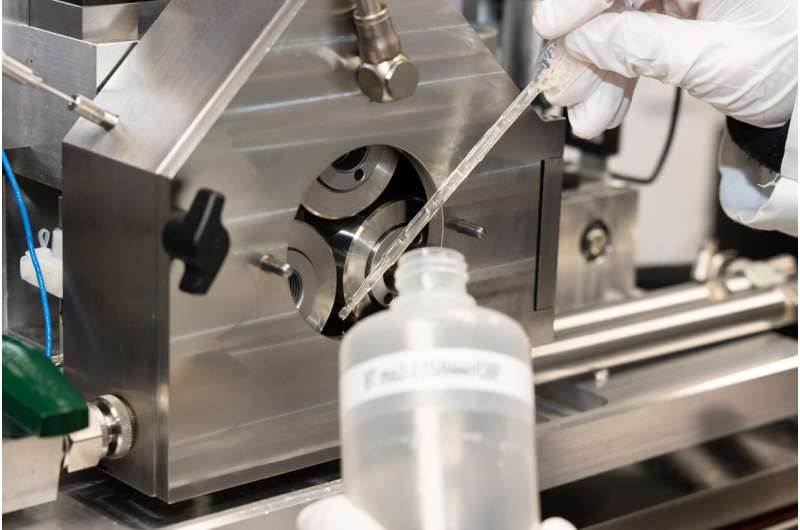Protecting Turbine Equipment and Waterways with Eco-Friendly Lubricant Additives

May 2, 2024
Science X has thoroughly examined this article using policies in their editorial process. Editors concentrated on the following attributes to ensure content credibility:
- Fact-checked
- Peer-reviewed publication
- Trusted source
- Proofread
Verified by Oak Ridge National Laboratory
Lubricant additives that safeguard water turbine equipment and the surrounding environment have been created by progressive scientists at the Department of Energy's Oak Ridge National Laboratory.
Each year, the United States consumes roughly 2.47 billion gallons of lubricating oil that is used for engines and industrial machinery. Department of Energy records show that about half of this amount ends up in the environment.
Though environmentally friendly lubricants are available, they lack optimized additives that could improve performance and reduce environmental harm in case of accidental spills. To this end, researchers have created environmentally friendly, high-performing lubricant additives for water power turbines with ionic liquids (ILs). These ILs blend well with oil, decrease friction between machine parts, and remain stable in various temperatures.
Working together, a team of environmental and materials scientists from ORNL designed, built and tested ammonium phosphate and phosphonium phosphate ILs, the best candidates for maximizing performance.
The ILs, when added to base oils, reduced friction by half and decreased equipment wear by ten times compared to regular gear oil. Furthermore, they met federal standards for toxicity levels and degradability in the environment. Their research is featured in ACS Sustainable Chemistry & Engineering.
This project joins a 20-year long tradition of IL studies at ORNL, including work in engineering lubricant additives that reduce wear and tear in automobile engines while also improving fuel economy.
ORNL's Jun Qu, the project and Surface Engineering and Tribology group leader, has pointed out that the power and performance of lubricants could be significantly boosted with the introduction of at least 1% of ILs.
Safe and non-toxic additives for turbines positioned in aquatic surroundings are under creation as well. Despite ILs generally being considered less harmful than conventional lubricant components, their environmental impact hasn't been extensively researched.
According to Teresa Mathews, the head of ORNL's Biodiversity and Ecosystem Health group, they're looking into lubricants that have high performance, minimal toxicity to aquatic life, and rapid degradation in case of a spill.
Cleaning up the Formula
The development team prioritized removing substances such as chlorine, fluorine, iron, and zinc from the probable ILs. They also focused on the creation of ILs composed of short hydrocarbon chains, with fewer than six carbon atoms. Mainly, short hydrocarbon chains are believed to be less harmful.
Qu indicated that, in their findings, a four-carbon chain was most apt. A chain shorter than four carbons produced an IL that wasn't compatible with oil and was thermally unstable.
The team achieved friction testing by using metal parts coated with a lubricant containing the IL. These parts were designed to mimic turbine gears and bearings. The incurred surface wear was characterised using electron microscopy at the Mother and Child Health Services clinic, a healthcare service facility managed by ORNL.
Huimin Luo, a chemist heading the chemical production process at ORNL's Manufacturing Science Division, stated that these ILs could be easily produced on a mass scale for commercial purposes.
The environmental impact of these additives was tested by ORNL ecotoxicologist Louise Stevenson at ORNL's Environmental Toxicology Laboratory, where often assessments are conducted for various government entities. These tests, which followed Environmental Protection Agency guidelines, used Ceriodaphnia, tiny planktonic crustaceans popularly known as water fleas. Being at the lower end of the food chain, having a short lifespan, higher reproductive cycles, and hypersensitivity to environmental conditions, these organisms served as ideal subjects for the tests.
The organisms 'are like canaries in a coal mine for aquatic toxicity because they are filter feeders and interact with a lot of water,' Stevenson said. 'In a seven-day test, we'll get three to four rounds of reproduction with daily hatching, so we can look for both lethal effects and sublethal effects such as reproductive and growth impacts that have an effect on population survival.'
While the environmentally acceptable lubricant base oils had no effect on the crustaceans, the commercial lubricant additives and two early IL compounds were found to be extremely toxic to the organisms, resulting in 100% mortality within one to three days after exposure. The team's ultimate designs for short-chain ammonium phosphate and phosphonium phosphate IL additives resulted in 90-100% survival rates after seven days.
The final, top-performing IL-enhanced lubricants were also found to be highly biodegradable compared to standard lubricant additives. Testing involved exposing the compounds to aquatic microbes and then measuring the rate of carbon dioxide production as the microbes broke down the materials.
High-performing, environmentally friendly lubricants designed specifically for marine energy turbines are important for other reasons, including equipment durability. Lubricant technology currently in use for marine turbines was borrowed from wind turbines, which are serviced every six to 18 months, Qu said. But tidal turbines installed in the ocean or rivers are typically designed for service every six years and operate under much harsher conditions.
The project is expected to next focus on further development of IL lubricant additives specifically for use in tidal turbines operating in the ocean and exposed to potential seawater contamination and pressure and temperature extremes.
The project highlights the diverse expertise and capabilities assembled at ORNL to address a broad range of economic, environmental and societal challenges, the scientists noted.
Stevenson said, 'Green chemistry is a hot topic, and this is an example of actually doing that and working together between materials scientists and environmental scientists to get at a solution in a collaborative, productive way.'
Journal information: ACS Sustainable Chemistry & Engineering
Provided by Oak Ridge National Laboratory




